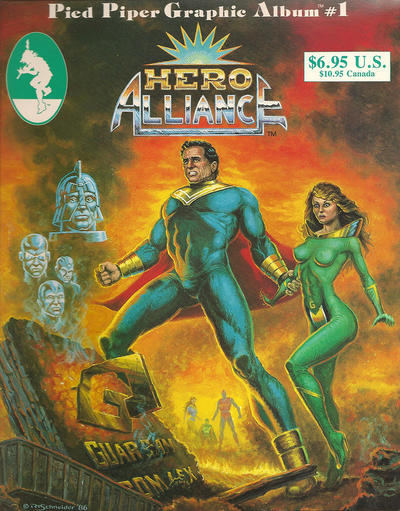The World Greatest Hero stares at the ruins of the headquarters of his ex-team. They’re dead, murdered by an old enemy nobody had taken seriously in years. Meanwhile, unknowing, his best friend lies dying in a hospital.

If this had been Superman and say the Detroit area Justice League this would have had some emotional impact. However instead it’s Victor, the heroes murdered were the Guardmen. You don’t know any of these people, why would you care about them when there’s three pages of backstory, then a splash page with the ruins of the team’s headquarters and that’s the last we’ll see of them. It’s purely setup for the rest of the Hero Alliance “End of the Golden Age” graphic novel, which is really about Victor and his relationship with that old friend, the Golden Guardsman, the Batman to his Superman. The Guardsman disappeared years ago and now lies dying of cancer, his son decides now it’s a good time to steal the source of his powers and become a supervillain while his daughter tries to stop him, calling on Victor to help her. In the end they succeed, but now Victor has to choose what to do next as the story is to be continued in the Hero Alliance regular series.
A bold gamble to launch a new superhero series in 1986 through a $6.95 graphic novel; toob old a gamble as Pied Piper didn’t last long beyond its publication. Another victim of the 1987 Black and White Comics Boom, when the direct market was overflowing by all sorts of amateurish crap hoping to be the next Teenage Mutant Ninja Turtles. When that fever broke a lot of shops and publishers went bankrupt. Hero Alliance only got one issue and that was at Wonder color Comics. But the story doesn’t end here.
My personal copy of Hero Alliance “End of the Golden Age” has a sticker over the price tage you see, “Distributed by Innovation”, raising the price with two bucks. What had happened there was that David Campiti, who had written the story together with Kevin Juaire, had started his own comics company in 1989, Innovation, and immediately restarted the Hero Alliance series. He also got the stock from Wonder and Pied Piper and resold it a few years later, taking old issues, ripping their covers off and bundling them together in 100 pages specials under a new cover. There must’ve also been a far few copies of the original graphic novel laying about for Innovation to resell them as is. Especially since Innovation had also reworked it into a three issue miniseries with the same title, adding that first issue from Wonder Color to it as well as extra material.
Now you may have noticed that the cover painting, by one R. T. Schneider, is, to put it bluntly rather ugly. Especially Victor and Kris’ facial expressions are terrible. Have no fear though, as the interior artwork is in much more capable hands, being some of the very first work done by one Ron Lim (with inking by Bart Sears even). Neither Lim nor Sears would make the jump to Innovation, having moved on to bigger and better things, but it is worth seeking out the graphic novel and that very first issue for their art.
Is Hero Alliance as a whole any good? Probably not. To paraphrase David Campiti, the intent was to “show the scenes between the fight scenes” and created a more mature sort of superhero series. In practise this meant second rate soap opera and a lot of t&a. Kris especially could not wear her costume without her nipples poking through. None of the characters got that much of a personality and it all remained stuck in them being obvious stand-ins for better known heroes. Nevertheless, the series lasted 17 issues, followed by a second, quarterly one that lasted four. Somebody must’ve liked it.
No Comments